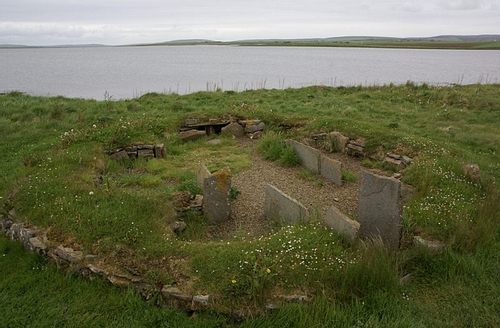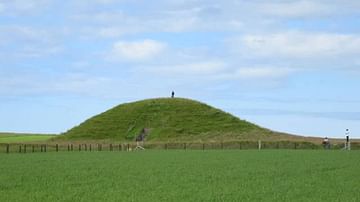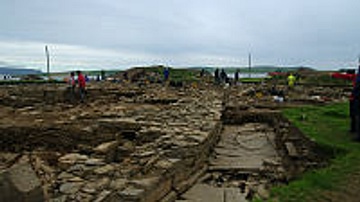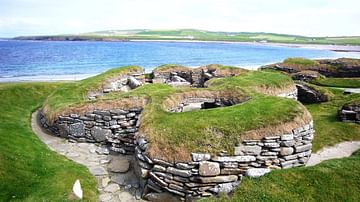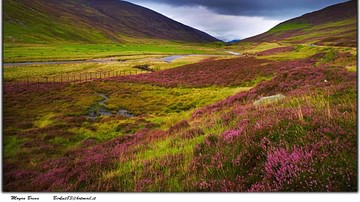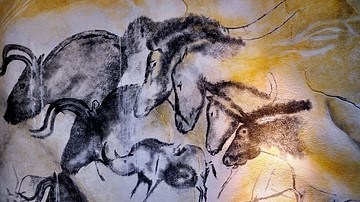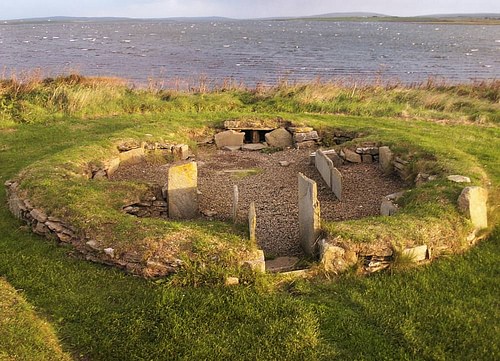
The Barnhouse Settlement is a Neolithic village located in Antaness, Orkney, Scotland, which was inhabited between c. 3300 and 2600 BCE. The present designation of 'Barnhouse' comes from the name of the farmland on which the village was discovered in 1984 CE by the archaeologist Dr. Colin Richards. Excavation of the site began in 1986 CE, revealing ten stone buildings which conformed in design and construction, though not in style, to the village of Skara Brae (c. 3100 BCE) located 5 miles (8 km) to the north-west. Only the foundations of these buildings remain intact as the village was deliberately destroyed, seemingly by the inhabitants, in 2600 BCE and centuries of agricultural activity on the farm displaced many of the loose stones. Grooved Ware pottery found at the site further links Barnhouse to Skara Brae and also to the nearby Standing Stones of Stenness where similar ceramics were uncovered. To date, fifteen buildings have been excavated and partially reconstructed. Unlike Skara Brae, where the houses were built into the earth and surrounded by midden, the structures which comprise Barnhouse were free-standing. Most of these are small buildings, which appear to have been homes while two large structures seem to have served other purposes.
Barnhouse as a Ceremonial Site
The site also comprises the famous monolith known as the Barnhouse Stone which is aligned directly to the passage entrance of Maeshowe, half a mile (800 m) to the north-east and to the Standing Stones of Stenness, by the same distance, to the north-west, to form a kind of triangle between the three structures. The Barnhouse Stone is thought to have played a significant role in rituals performed at these nearby sites as did the village itself. Proximity to the enormous complex presently being excavated at the Ness of Brodgar, and the alignment of Maeshowe, Barnhouse, the Standing Stones of Stenness, the Watchstone, Ness of Brodgar, and Ring of Brodgar, seem to confirm a clear connection between all these sites. Mr. Peter Flett observed, in 1952 CE, that the Barnhouse Stone is aligned with the Watchstone in a direct line to the center of the Ring of Brodgar and points to the rising sun on 1 May, the traditional date of the pagan Sabbat of Beltane (Orkneyjar.com).
The buildings of the village were constructed along the same lines as those at Skara Brae and many feature the same design of a central, kerbed hearth, stone furniture, recessed stone beds, and `dressers'. The two large buildings designated Structure Two and Structure Eight, however, are noticeably different in style and size and suggest use as ritualistic community centers rather than domiciles. All the houses at Skara Brae are identical in feature and size and this has been interpreted to mean that the community considered everyone in the village as equally important, with no chief or ruling class given any special accommodations. These two larger structures at Barnhouse suggest the theory that this community was centered on someone or something they considered of great importance. As the Barnhouse Settlement lies in proximity to so many other sites clearly identified as ceremonial in nature, it has been suggested that the larger structures were the dwellings of a priestly class who officiated at rituals held at Maeshowe, the Standing Stones of Stenness, The Ness of Brodgar, and Ring of Brodgar. It is equally possible, however, that the two structures were themselves ceremonial sites.
Structure Two & Structure Eight
Structure Two conforms to the design of a chambered cairn in which rituals were known to take place elsewhere and Structure Eight contains a 'dresser', which has been interpreted as a kind of altar, as well as what appears to have been offerings. One such offering, perhaps, is a Grooved Ware ceramic pot, containing fourteen pieces of flint, found near the hearth in Structure Eight. As flint was rare on Orkney, a pot containing fourteen nodules of the stone would have been very valuable and considered an impressive sacrifice. As there is no way to determine what the ceramic pot of stone signified to the ancients, however, it is unknown whether the flint was an offering or simply a valuable which was kept by the hearth.
That Structure Two could have been the home of a person or persons of importance is possible as the building was in use throughout the life of the village. Certain features, however, such as a stone cist filled with human bones, suggests a ritual use. This cist, covered by a triangle of stone, was positioned so that anyone entering the building would have to walk across it. Further, the chambers of Structure Two do not conform to other sites (such as Skara Brae) where sleeping quarters have been identified. The purpose and use of Structure Eight (located directly across from Structure Two) is equally mysterious.
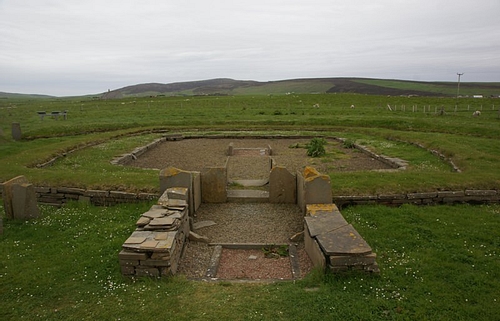
Structure Eight is the largest edifice in the village and is built, like Maeshowe, on a platform of clay. The building was originally roofed (as all the structures of the village were) and contained a central hearth and 'dresser' flanked by two large stones. The layout of the interior, especially the long passageway between the entrance and the hearth and dresser, suggests a definite ritual use. It has been suggested that this building represents a shift in religious understanding as the paradigm of services changed from outdoor ceremonies, which included the entire community, to cloistered rituals which were only for the initiated. This theory seems to rest partially on dating the Standing Stones of Stenness, where open-air rituals were known to have taken place, earlier than the accepted date of 3000 BCE. It has therefore been argued, especially in light of the recent excavations at the Ness of Brodgar, that Structure Eight was another of the ceremonial sites which made up part of what is now seen as a complex stretching from Barnhouse through the sites leading to the Ring of Brodgar and is not evidence of change in religious understanding. The evidence of offerings at the hearth in Structure Eight and the bone-filled cist in Structure Two have been seen to support the theory that these buildings were used to either commune with, remember, or honor the dead and this seems in keeping with finds at the Ness of Brodgar.
Barnhouse Abandonment
It is well substantiated that Barnhouse Settlement (including Structure Two) and the Standing Stones of Stenness were in use at the same time but, it should be noted, Structure Eight was built later than the rest of the village (c. 2600 BCE) and, in fact, after the village had been abandoned and purposefully destroyed. Evidence suggests that all of the buildings were simultaneously demolished sometime around 2600 BCE at the same time Structure Eight was raised and this has further bolstered the theory of a dramatic change in religious understanding and practice dated to this time. The existence of the `blocking stone' in the entrance passage at Maeshowe has been interpreted as evidence that closed rituals may have been performed at that site as well. Since no definite evidence found thus far fully substantiates this theory, however, it must remain conjecture. Skara Brae was once thought to be unique until the discovery of Barnhouse and Structure Eight was the largest roofed Neolithic Age building to be uncovered until the recent discovery of Structure Ten at the Ness of Brodgar. Excavations at that site have already changed the way the other nearby sites are understood and archaeologists are confident that continuing work there will reveal many more important finds which will further clarify what now remains mysterious.
